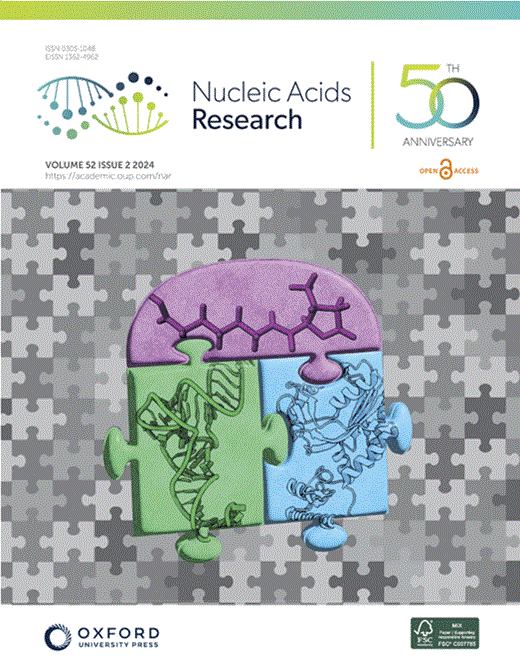m6A修饰被合并到细菌mRNA中,没有特定的功能益处。
IF 16.6
2区 生物学
Q1 BIOCHEMISTRY & MOLECULAR BIOLOGY
引用次数: 0
摘要
n6 -甲基腺苷(m6A)是真核信使rna (mrna)中最丰富的修饰,在细菌mrna中也发现了低水平的修饰。然而,在细菌中引入m6A修饰mrna的酶仍然是难以捉摸的。在这项工作中,我们将鉴定m6A位点的深度测序方法与体外生化研究相结合,以鉴定可能修饰大肠杆菌mrna的m6A甲基转移酶。我们测试了四种未知的候选基因,这些候选基因被预测编码具有甲基转移酶结构域的蛋白质,其缺失会降低m6A水平。然而,用纯化的推定甲基转移酶进行的体外分析显示,它们都没有在mRNA上安装m6A。暴露于高温和氧化应激也改变了m6A水平;然而,我们发现m6A变化与特定应力之间没有明显的相关性。考虑到两种不同分辨率的深度测序方法,我们发现细菌mrna上的m6A甲基化非常低,并且似乎是随机引入的。这些结果表明,与真核生物相比,细菌mRNA中的m6A修饰缺乏直接的酶识别机制,没有明确的生物学功能。本文章由计算机程序翻译,如有差异,请以英文原文为准。
m6A modification is incorporated into bacterial mRNA without specific functional benefit.
N 6-Methyladenosine (m6A), the most abundant modification in eukaryotic messenger RNAs (mRNAs), has also been found at a low level in bacterial mRNAs. However, enzyme(s) that introduce m6A modification on mRNAs in bacteria remain elusive. In this work, we combine deep-sequencing approaches that identify m6A sites with in vitro biochemical studies to identify putative m6A methyltransferases that would modify Escherichia coli mRNAs. We tested four uncharacterized candidates predicted to encode proteins with putative methyltransferase domains, whose deletion decreased the m6A level. However, in vitro analysis with the purified putative methyltransferases revealed that none of them installs m6A on mRNA. Exposure to heat and oxidative stress also changed the m6A level; however, we found no clear correlation between the m6A change and the specific stress. Considering two deep-sequencing approaches with different resolution, we found that m6A methylation on bacterial mRNAs is very low and appears randomly introduced. These results suggest that, in contrast to eukaryotes, the m6A modification in bacterial mRNA lacks a direct enzymatic recognition mechanism and has no clear biological function.
求助全文
通过发布文献求助,成功后即可免费获取论文全文。
去求助
来源期刊

Nucleic Acids Research
生物-生化与分子生物学
CiteScore
27.10
自引率
4.70%
发文量
1057
审稿时长
2 months
期刊介绍:
Nucleic Acids Research (NAR) is a scientific journal that publishes research on various aspects of nucleic acids and proteins involved in nucleic acid metabolism and interactions. It covers areas such as chemistry and synthetic biology, computational biology, gene regulation, chromatin and epigenetics, genome integrity, repair and replication, genomics, molecular biology, nucleic acid enzymes, RNA, and structural biology. The journal also includes a Survey and Summary section for brief reviews. Additionally, each year, the first issue is dedicated to biological databases, and an issue in July focuses on web-based software resources for the biological community. Nucleic Acids Research is indexed by several services including Abstracts on Hygiene and Communicable Diseases, Animal Breeding Abstracts, Agricultural Engineering Abstracts, Agbiotech News and Information, BIOSIS Previews, CAB Abstracts, and EMBASE.
 求助内容:
求助内容: 应助结果提醒方式:
应助结果提醒方式:


